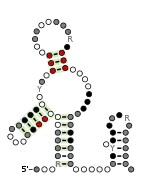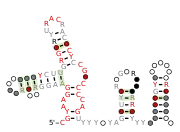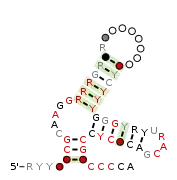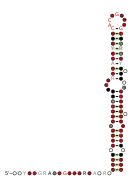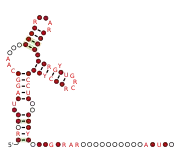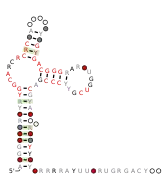Flavivirus 3' UTR are untranslated regions in the genome of viruses in the genus Flavivirus.
Background
The Flavivirus positive-oriented, single-stranded RNA genome has a length of 10,000 - 11,000 bases. The genus includes human pathogens like Zika virus, West-Nile virus, Dengue virus, Yellow Fever virus and other.[1]
The 3' UTR ranges between 400 and 700 nucleotides in length.[2] Its RNA secondary structure is known to be necessary for the viral replication during infection. In contrast to the structurally conserved 5' UTR of flaviviruses, individual structural elements differ between different viruses, which is associated with the host-adaptation. Flaviviruses are therefore classified into four different groups: Mosquito-borne flaviviruses (MBFV), tick-borne flaviviruses (TBFV), insect-specific flaviviruses (ISFV) and those with no known vector (NKV).[3][4]
Across all groups, three RNA secondary structure elements are conserved within the 3' UTR: the dumbbell element (DB), cis-acting replication element (CRE) and the exoribonuclease-resistant RNA elements (xrRNA). Further, unique elements have been observed for specific groups as well.
Subgenomic flavivirus RNA
The 3' UTR of flavivirus - and sometimes even a small part of the 3' end of the coding region - is also called subgenomic flavivirus RNA (sfRNA).[5] It has been shown that sfRNA is implied in many different pathways that comprises both, host defenses and viral infection.[6][7][8] SfRNA is produced by incomplete degradation of the viral genome by the host cell (via XRN1).[9] Local RNA secondary structures (xrRNA elements) in the 3' UTR and long-range RNA-RNA interactions between 5' UTR and 3' UTR of flaviviruses stall XRN1 and causes the undigested fragment of the genome.
xrRNA element
The exoribonuclease-resistant RNA elements (xrRNA) are described throughout all groups of flaviviruses. Usually, each virus harbors two xrRNAs, xrRNA1 and xrRNA2, in the beginning of the 3' UTR.[10] The formation of these stem-loops, especially xrRNA1, is vital to ensure resistance against XRN1 activity.[11] The Y-shaped stem-loop is also termed SL II and SL IV, respectively. In order to function as xrRNA, the sequence downstream is needed as well, since the upper loop region forms a pseudoknot (PK) with the single-stranded region directly downstream to its respective hairpin. In some species, the region downstream also forms a small hairpin. In such cases, the PK interactions takes place between the two loop regions. Conserved formation of these structures were observed in mammalian cells but not in mosquito cells, suggesting this region has varying functions in different hosts.[12][13] In plant-viruses, xrRNA elements have been observed as well, showing some similarities to flaviviral xrRNAs.[14][15] However, plant-virus xrRNA and flaviviral xrRNA are distinguishable by their underlying three-dimensional folds.[16] It has been reported that xrRNAs block the progression of 5' to 3' exoribonuclease producing subgenomic RNAs.[3] xrRNA elements can be found in some of the deadliest viruses in agriculture including, potato leafroll virus (PLRV), leading responsible virus for worldwide potato yield loss,[5] maize chlorotic mottle virus (MCMV), responsible for 90% maize/corn yield loss in sub-Saharan Africa,[6] and maize yellow dwarf virus-RMV (MYDV- RMV), formerly BYDV-RMV.[7]
Dumbbell element
The dumbbell element (DB) are important for viral RNA synthesis.[17] Via the formation of additional pseudoknots, the loop regions of DB pairs with a complementary motif further downstream of the respective DB element.[18][19] The DB elements also expose conserved sequences (CS) and repeated conserved sequences (RCS).[20] Further, the DB elements are also playing a role in viral translation, as deletion of both elements reduced viral translation levels.[21][22]
Pseudoknot-forming stem-loops
There is evidence that pseudoknot-forming stem-loops (SL-PK) are encoded by dual-host insect-specific flaviviruses and classical insect-specific flaviviruses[23] but while short stem-loops are present in the genomes of all mosquito-borne flaviviruses, they are not involved in pseudoknot interactions for which structural is available.[24][25] It is thought that SL-PK might stabilise xrRNAs or confer additional XRN1 resistance as abolishing the SL-PK of various viruses reduces the production of sfRNAs.[23]
CRE structure
The cis-acting replication element (CRE) structure is structurally conserved among known flaviviruses. It consists of a small hairpin (sHP) and a larger structural element (3'SL). Mutations of sHP are shown to be lethal for Dengue virus in mosquito cells.[26] CRE is highly involved in the 5'-3' UTR interaction of flaviviruses.[27] Regions of sHP are interacting with the SLB element and the cHP in the 5' UTR, whereas the 3'SL harbors a sequence that can interact with SLB, to further stabilize this long-range RNA-RNA interaction.
Repeated elements
In ISFV, structural alignments of the 3' UTR revealed that many species harbor three to four repeats of two highly conserved elements, termed Ra and Rb.[28][29] These elements show variable loop regions and low sequence conservation in the Ra element. However, strong structure conservation and the occurrence of multiple copies may hint towards a possible functional importance of these elements.[29]
SL6 short hairpin
In different studies, a short stem-loop, named SL6 has been observed in at least TBEV, LGTV and OHFV.[30][31] SL6 shows a high heterogeneity among different tick-borne flaviviruses, but is structurally conserved supported by multiple covariation.[29]
References
- ↑ "International Committee on Taxonomy of Viruses (ICTV)". talk.ictvonline.org. Retrieved 2020-08-14.
- ↑ Ng, Wy; Soto-Acosta, Ruben; Bradrick, Shelton; Garcia-Blanco, Mariano; Ooi, Eng (2017-06-06). "The 5′ and 3′ Untranslated Regions of the Flaviviral Genome". Viruses. 9 (6): 137. doi:10.3390/v9060137. ISSN 1999-4915. PMC 5490814. PMID 28587300.
- 1 2 Kuno, Goro; Chang, Gwong-Jen J.; Tsuchiya, K. Richard; Karabatsos, Nick; Cropp, C. Bruce (1998-01-01). "Phylogeny of the Genus Flavivirus". Journal of Virology. 72 (1): 73–83. doi:10.1128/JVI.72.1.73-83.1998. ISSN 1098-5514. PMC 109351. PMID 9420202.
- ↑ Gaunt, Michael W.; Sall, Amadou A.; Lamballerie, Xavier de; Falconar, Andrew K. I.; Dzhivanian, Tatyana I.; Gould, Ernest A. (2001-08-01). "Phylogenetic relationships of flaviviruses correlate with their epidemiology, disease association and biogeography". Journal of General Virology. 82 (8): 1867–1876. doi:10.1099/0022-1317-82-8-1867. ISSN 0022-1317. PMID 11457992.
- 1 2 Bidet, Katell; Garcia-Blanco, Mariano A. (2014-09-01). "Flaviviral RNAs: weapons and targets in the war between virus and host". Biochemical Journal. 462 (2): 215–230. doi:10.1042/BJ20140456. ISSN 0264-6021. PMID 25102029.
- 1 2 Chang, Ruey-Yi; Hsu, Ta-Wen; Chen, Yen-Lin; Liu, Shu-Fan; Tsai, Yi-Jer; Lin, Yun-Tong; Chen, Yi-Shiuan; Fan, Yi-Hsin (2013-09-01). "Japanese encephalitis virus non-coding RNA inhibits activation of interferon by blocking nuclear translocation of interferon regulatory factor 3". Veterinary Microbiology. 166 (1–2): 11–21. doi:10.1016/j.vetmic.2013.04.026. PMID 23755934.
- 1 2 Moon, S. L.; Anderson, J. R.; Kumagai, Y.; Wilusz, C. J.; Akira, S.; Khromykh, A. A.; Wilusz, J. (2012-11-01). "A noncoding RNA produced by arthropod-borne flaviviruses inhibits the cellular exoribonuclease XRN1 and alters host mRNA stability". RNA. 18 (11): 2029–2040. doi:10.1261/rna.034330.112. ISSN 1355-8382. PMC 3479393. PMID 23006624.
- ↑ Clarke, B.D.; Roby, J.A.; Slonchak, A.; Khromykh, A.A. (2015-08-01). "Functional non-coding RNAs derived from the flavivirus 3′ untranslated region". Virus Research. 206: 53–61. doi:10.1016/j.virusres.2015.01.026. PMID 25660582.
- ↑ Chapman, E. G.; Costantino, D. A.; Rabe, J. L.; Moon, S. L.; Wilusz, J.; Nix, J. C.; Kieft, J. S. (2014-04-18). "The Structural Basis of Pathogenic Subgenomic Flavivirus RNA (sfRNA) Production". Science. 344 (6181): 307–310. Bibcode:2014Sci...344..307C. doi:10.1126/science.1250897. ISSN 0036-8075. PMC 4163914. PMID 24744377.
- ↑ Pijlman, Gorben P.; Funk, Anneke; Kondratieva, Natasha; Leung, Jason; Torres, Shessy; van der Aa, Lieke; Liu, Wen Jun; Palmenberg, Ann C.; Shi, Pei-Yong; Hall, Roy A.; Khromykh, Alexander A. (2008-12-11). "A highly structured, nuclease-resistant, noncoding RNA produced by flaviviruses is required for pathogenicity". Cell Host & Microbe. 4 (6): 579–591. doi:10.1016/j.chom.2008.10.007. ISSN 1934-6069. PMID 19064258.
- ↑ Moon, Stephanie L.; Anderson, John R.; Kumagai, Yutaro; Wilusz, Carol J.; Akira, Shizuo; Khromykh, Alexander A.; Wilusz, Jeffrey (2012-11-01). "A noncoding RNA produced by arthropod-borne flaviviruses inhibits the cellular exoribonuclease XRN1 and alters host mRNA stability". RNA. 18 (11): 2029–2040. doi:10.1261/rna.034330.112. ISSN 1469-9001. PMC 3479393. PMID 23006624.
- ↑ Villordo, Sergio M.; Filomatori, Claudia V.; Sánchez-Vargas, Irma; Blair, Carol D.; Gamarnik, Andrea V. (2015-01-30). Nagy, Peter D. (ed.). "Dengue Virus RNA Structure Specialization Facilitates Host Adaptation". PLOS Pathogens. 11 (1): e1004604. doi:10.1371/journal.ppat.1004604. ISSN 1553-7374. PMC 4311971. PMID 25635835.
- ↑ Ng, Wy Ching; Soto-Acosta, Ruben; Bradrick, Shelton S.; Garcia-Blanco, Mariano A.; Ooi, Eng Eong (2017-06-06). "The 5′ and 3′ Untranslated Regions of the Flaviviral Genome". Viruses. 9 (6): 137. doi:10.3390/v9060137. ISSN 1999-4915. PMC 5490814. PMID 28587300.
- ↑ Iwakawa, Hiro-oki; Mizumoto, Hiroyuki; Nagano, Hideaki; Imoto, Yuka; Takigawa, Kazuma; Sarawaneeyaruk, Siriruk; Kaido, Masanori; Mise, Kazuyuki; Okuno, Tetsuro (2008-10-15). "A Viral Noncoding RNA Generated by cis-Element-Mediated Protection against 5′→3′ RNA Decay Represses both Cap-Independent and Cap-Dependent Translation". Journal of Virology. 82 (20): 10162–10174. doi:10.1128/JVI.01027-08. ISSN 0022-538X. PMC 2566255. PMID 18701589.
- ↑ Steckelberg, Anna-Lena; Akiyama, Benjamin M.; Costantino, David A.; Sit, Tim L.; Nix, Jay C.; Kieft, Jeffrey S. (2018-06-19). "A folded viral noncoding RNA blocks host cell exoribonucleases through a conformationally dynamic RNA structure". Proceedings of the National Academy of Sciences. 115 (25): 6404–6409. Bibcode:2018PNAS..115.6404S. doi:10.1073/pnas.1802429115. ISSN 0027-8424. PMC 6016793. PMID 29866852.
- ↑ Steckelberg, Anna-Lena; Vicens, Quentin; Costantino, David A.; Nix, Jay C.; Kieft, Jeffrey S. (2020-05-01). "The crystal structure of a Polerovirus exoribonuclease-resistant RNA shows how diverse sequences are integrated into a conserved fold". bioRxiv. doi:10.1101/2020.04.30.070631. S2CID 218530297.
- ↑ Sztuba-Solinska, Joanna; Teramoto, Tadahisa; Rausch, Jason W.; Shapiro, Bruce A.; Padmanabhan, Radhakrishnan; Le Grice, Stuart F. J. (2013-05-01). "Structural complexity of Dengue virus untranslated regions: cis-acting RNA motifs and pseudoknot interactions modulating functionality of the viral genome". Nucleic Acids Research. 41 (9): 5075–5089. doi:10.1093/nar/gkt203. ISSN 1362-4962. PMC 3643606. PMID 23531545.
- ↑ Shi, P. Y.; Brinton, M. A.; Veal, J. M.; Zhong, Y. Y.; Wilson, W. D. (1996-04-02). "Evidence for the existence of a pseudoknot structure at the 3' terminus of the flavivirus genomic RNA". Biochemistry. 35 (13): 4222–4230. doi:10.1021/bi952398v. ISSN 0006-2960. PMID 8672458.
- ↑ Olsthoorn, R. C.; Bol, J. F. (2001-10-01). "Sequence comparison and secondary structure analysis of the 3' noncoding region of flavivirus genomes reveals multiple pseudoknots". RNA. 7 (10): 1370–1377. ISSN 1355-8382. PMC 1370180. PMID 11680841.
- ↑ Hahn, C. S.; Hahn, Y. S.; Rice, C. M.; Lee, E.; Dalgarno, L.; Strauss, E. G.; Strauss, J. H. (1987-11-05). "Conserved elements in the 3' untranslated region of flavivirus RNAs and potential cyclization sequences". Journal of Molecular Biology. 198 (1): 33–41. doi:10.1016/0022-2836(87)90455-4. ISSN 0022-2836. PMID 2828633.
- ↑ Romero, T. A.; Tumban, E.; Jun, J.; Lott, W. B.; Hanley, K. A. (2006-11-01). "Secondary structure of dengue virus type 4 3' untranslated region: impact of deletion and substitution mutations". Journal of General Virology. 87 (11): 3291–3296. doi:10.1099/vir.0.82182-0. ISSN 0022-1317. PMID 17030863.
- ↑ Manzano, Mark; Reichert, Erin D.; Polo, Stephanie; Falgout, Barry; Kasprzak, Wojciech; Shapiro, Bruce A.; Padmanabhan, Radhakrishnan (2011-06-24). "Identification of Cis -Acting Elements in the 3′-Untranslated Region of the Dengue Virus Type 2 RNA That Modulate Translation and Replication". Journal of Biological Chemistry. 286 (25): 22521–22534. doi:10.1074/jbc.M111.234302. ISSN 0021-9258. PMC 3121397. PMID 21515677.
- 1 2 Slonchak A, Parry R, Pullinger B, Sng JDJ, Wang X, Buck TF; et al. (2022). "Structural analysis of 3'UTRs in insect flaviviruses reveals novel determinants of sfRNA biogenesis and provides new insights into flavivirus evolution". Nat Commun. 13 (1): 1279. Bibcode:2022NatCo..13.1279S. doi:10.1038/s41467-022-28977-3. PMC 8917146. PMID 35277507. S2CID 247407895.
{{cite journal}}: CS1 maint: multiple names: authors list (link) - ↑ Funk A, Truong K, Nagasaki T, Torres S, Floden N, Balmori Melian E; et al. (2010). "RNA structures required for production of subgenomic flavivirus RNA". J Virol. 84 (21): 11407–17. doi:10.1128/JVI.01159-10. PMC 2953152. PMID 20719943.
{{cite journal}}: CS1 maint: multiple names: authors list (link) - ↑ Chapman EG, Moon SL, Wilusz J, Kieft JS (2014). "RNA structures that resist degradation by Xrn1 produce a pathogenic Dengue virus RNA". eLife. 3: e01892. doi:10.7554/eLife.01892. PMC 3968743. PMID 24692447.
{{cite journal}}: CS1 maint: multiple names: authors list (link) - ↑ Villordo, Sergio M.; Gamarnik, Andrea V. (2013-08-01). "Differential RNA sequence requirement for dengue virus replication in mosquito and mammalian cells". Journal of Virology. 87 (16): 9365–9372. doi:10.1128/JVI.00567-13. ISSN 1098-5514. PMC 3754043. PMID 23760236.
- ↑ Fernández-Sanlés, Alba; Ríos-Marco, Pablo; Romero-López, Cristina; Berzal-Herranz, Alfredo (2017-04-03). "Functional Information Stored in the Conserved Structural RNA Domains of Flavivirus Genomes". Frontiers in Microbiology. 8: 546. doi:10.3389/fmicb.2017.00546. ISSN 1664-302X. PMC 5376627. PMID 28421048.
- ↑ Hoshino, Keita; Isawa, Haruhiko; Tsuda, Yoshio; Yano, Kazuhiko; Sasaki, Toshinori; Yuda, Masao; Takasaki, Tomohiko; Kobayashi, Mutsuo; Sawabe, Kyoko (2007-03-01). "Genetic characterization of a new insect flavivirus isolated from Culex pipiens mosquito in Japan". Virology. 359 (2): 405–414. doi:10.1016/j.virol.2006.09.039. PMID 17070886.
- 1 2 3 Ochsenreiter, Roman; Hofacker, Ivo; Wolfinger, Michael (2019-03-24). "Functional RNA Structures in the 3′UTR of Tick-Borne, Insect-Specific and No-Known-Vector Flaviviruses". Viruses. 11 (3): 298. doi:10.3390/v11030298. ISSN 1999-4915. PMC 6466055. PMID 30909641.
- ↑ Gritsun, T.S.; Gould, E.A. (2006), "Origin and Evolution of 3′Utr of Flaviviruses: Long Direct Repeats as A Basis for the Formation of Secondary Structures and Their Significance for Virus Transmission", Advances in Virus Research, Elsevier, 69: 203–248, doi:10.1016/s0065-3527(06)69005-2, ISBN 978-0-12-373712-0, PMID 17222695, retrieved 2020-08-27
- ↑ Gritsun, Dmitri J.; Jones, Ian M.; Gould, Ernest A.; Gritsun, Tamara S. (2014-03-19). Donlin, Maureen J. (ed.). "Molecular Archaeology of Flaviviridae Untranslated Regions: Duplicated RNA Structures in the Replication Enhancer of Flaviviruses and Pestiviruses Emerged via Convergent Evolution". PLOS ONE. 9 (3): e92056. Bibcode:2014PLoSO...992056G. doi:10.1371/journal.pone.0092056. ISSN 1932-6203. PMC 3960163. PMID 24647143.
